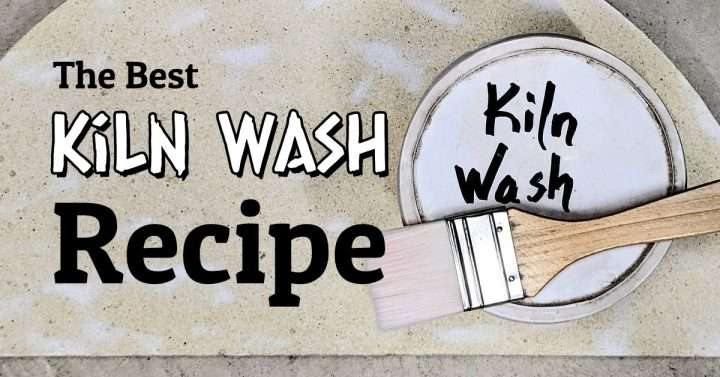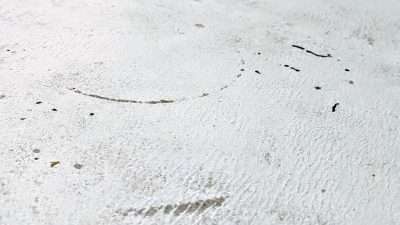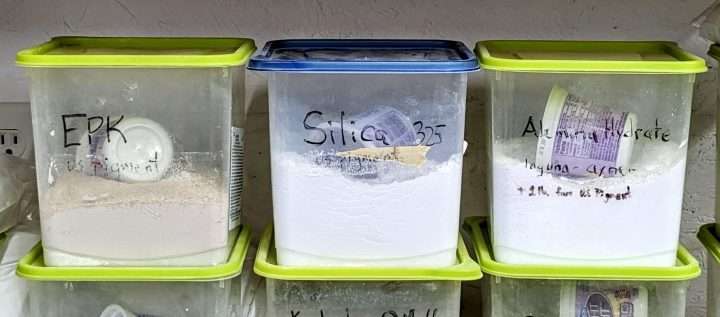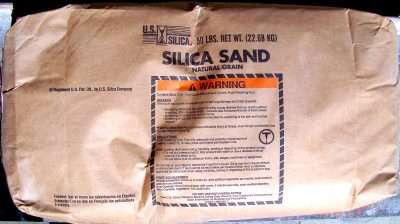
Finding the best kiln wash recipe may take a little experimenting to discover the perfect recipe for your situation. Below you will find some great recipes and learn what kiln wash is made of, what it is used for, and alternatives to using kiln wash. Though it may be an uninspiring topic, it is an important part of firing pottery for many potters.
What is Kiln Wash?
A simple definition:
Kiln wash is a refractory substance applied to kiln shelves to help protect them during firing. Kiln wash is also known as bat wash, shelf primer, or kiln shelf wash.
Why Should I Use Kiln Wash?
When firing pottery there is a chance that glaze (or certain clays) can fuse to a kiln shelf. This could damage or ruin your kiln shelves and your pots. Kiln wash can keep the glaze or clay from sticking to the shelf.

If there are glaze drips or runs, pots falling, overfiring, or any other situation where glaze or clay can fuse to the shelf, it is a good idea to have a protective layer of kiln wash on your shelves.
Kiln Wash Ingredients
What is kiln wash made of? There are many different recipes but some of the most common ingredients include kaolin, alumina, and silica. Kiln wash ingredients are refractory, which means they are resistant to heat and will not melt at pottery-firing temperatures.

Alumina is a very refractory material and can be used by itself on kiln shelves, even in dry, powdered form. But powdered alumina can make a mess or accidently drop on your pots. It is also more expensive than other materials like Kaolin and Silica.
Kaolin (often EPK) is a refractory material with very small particles and a price tag that isn’t much more than silica. It helps other materials to stay in place when applied to a kiln shelf and also keeps kiln wash from settling to the bottom of a bucket. It shrinks when it is dried and fired so too much in a recipe could cause the kiln wash to flake off the shelf.
Calcined Kaolin is Kaolin that has been fired hot enough to burn out chemically bonded water. This makes it shrink less when used in a recipe. You can calcine Kaolin by putting some through a bisque firing.
Silica is a very refractory material and is relatively cheap. It may improve the durability of kiln wash. Some potters spread silica sand on their kiln shelves in place of, or in addition to, kiln wash. Silica can melt if it comes into contact with a flux so there shouldn’t be too much in your kiln wash ratio and it is not recommended for atmospheric firing.
Zirconium Silicate (Zircopax/Ultrox) is not as common in kiln wash recipes, probably because it is more expensive than other materials, but is one of the most refractory materials available. It also has small particles which improve brushability and suspension. It also increases the density of the kiln wash.
Epsom Salts can be added to a kiln wash to improve suspension and brushability.
CMC Gum also improves brushability and slows drying speed. It is an organic material so it can start to grow mold after a while. Some kind of antimicrobial can be added to avoid this.
What is the Best Kiln Wash Recipe?
There probably isn’t a perfect recipe for every potter and situation. Since there are many different kilns, firing temperatures, atmospheres, and firing techniques, you should look for a kiln wash recipe that fits your situation the best.
Here are a few characteristics to consider as you select the best kiln wash for yourself:
- Keeps pots, glaze, and posts from sticking to kiln shelves – obviously
- Ease of application – brushing or rolling should be quick and easy
- No curling, bubbling, or flaking while firing – this can ruin pots
- Easy to remove from shelves – kiln wash can be formulated to scrape off easily with a tool or even a fingernail
- Cost effectiveness – expensive materials may perform better but a recipe needs to fit your budget
- A simple kiln wash recipe – only a few, easy to acquire ingredients would be ideal
Some of the links below are affiliate links. If you make a purchase by clicking on one of the links, I get a small percent of the sale with no extra cost to you.
Kiln Wash Recipes
There are plenty of commercially available kiln washes for purchase (some on Amazon) but mixing kiln wash is easy. Mixing your own kiln wash allows you to make adjustments and know exactly what is in the kiln wash.
Some recipes are very specific, down to the gram. Some recipes are more general and may even be recorded by volume such as scoops or cups. Some recipes may even be in “parts” which technically could be either. Check the recipe instructions if you are unsure.
Here are a number options to find your perfect homemade kiln wash recipe.
General Kiln Wash Recipes
Ceramics: A Potter’s Handbook (Amazon) and many other sources
- 50 Silica
- 50 Kaolin
Plainsman Super Kiln Wash
- 400g Zircopax
- 100g Calcined Kaolin
- 113g Laguna Gum Solution (CMC)
- 200g Water
- 2g Calcium Chloride
Campana Self-Leveling Kiln Wash
- 2500g EPK
- 2500g Glomax
- 5000g Alumina Hydrate
- 4250 ml Water
- 25g Darvan 7
Earl Brunner
- 60 alumina Hydrate
- 30 Kaolin
- 10 bentonite
Neil Estrick Recipe (by volume)
- 1 scoop EPK
- 1 scoop Calcined EPK
- 1 scoop Alumina
- 2 scoops Silica
Sue McLeod Recipe (by volume)
- 2 scoops Alumina Hydrate
- 1 scoop EPK
- 1 scoop Calcined EPK
- 1 scoop Silica
Working Potter’s ITC (from Tony Clennell)
This can be used as a kiln wash but is designed to coat the inside surface of kilns.
- 2 parts Alumina Hydrate
- 2 parts 35 mesh Kyanite
- 2 parts Zirconium (Zircopax, Opax) this is expensive!
- 1 part Vee gum T
“I use weight and not volume” -Tony
Recipes collected by John Britt
Found in The Complete Guide to High Fire Glazes (Amazon), and/or posted here.
Super Awesome No Crack Kiln Wash
- 25g Calcined EPK
- 25g EPK
- 50g Alumina hydrate
- 1g G-200 Feldspar
Karl’s Killer Kiln Wash
- 40% Ultrox
- 30% Kaolin
- 20% Silica
- 10% Ball Clay
Buck’s Kiln Wash
- 32 Alumina Hydrate
- 35 Kaolin
- 17 Kyanite (35 mesh)
- 16 Sand
Arbuckle Kiln Wash
- 33 Kaolin
- 33 Glomax (Calcined Kaolin)
- 33 Silica
Combo
- 40 Alumina Hydrate
- 30 Kaolin
- 8 Kyanite (35-mesh)
- 22 Silica Sand
Robert Tetu
- 50 Alumina Hydrate
- 25 Silica
- 25 Kaolin
Daly
- 80 Alumina Oxide
- 20 Kaolin
Schuld
- 100 Alumina Hydrate
- 1 part white glue
- 3 parts water
Kiln Wash I
- 90 Zircopax
- 10 EPK (or Bentonite according to other sources)
Kiln Wash II
- 25 EPK
- 25 Calcined EPK
- 25 Zircopax
- 25 Alumina Hydrate
Kiln Wash III
- 28 Calcined EPK
- 18 EPK
- 45 Silica
- 9 Alumina Hydrate
Pier Kiln Wash
- 40% Pyrotrol or Pyrax (Pyrophyllite)
- 25% Calcined Kaolin (EPK)
- 35% Kaolin (EPK)
Cone 6 Kiln Wash Recipe
Any of the recipes on this page should work for mid range firing. Here is a recipe formulated specifically for cone 5 or 6.
Studio Manager Mid Range Kiln Wash Recipe
- 50% EPK or Kaolin
- 50% Alumina Hydrate
- 1% NC4 Feldspar
Cone 10 / High Fire Kiln Wash Recipe
Seattle Pottery Supply Kiln Wash Cone 10
- 5 parts silica
- 5 parts EPK
- 1 parts om4
Mix to a specific gravity of 1.8 – 1.9 with a high speed mixer.
Atmospheric Kiln Wash Recipes
Basic Salt – Found in The Complete Guide to High-Fire Glazes (Amazon)
- 50 Alumina Hydrate
- 50 Kaolin
Do I Have to Use Kiln Wash?
Kiln wash is very common but it isn’t the only option to protect your kiln shelves from damage. There are other techniques and materials that can be used in place of, or in addition to, kiln wash. Using kiln wash is relatively easy so it is a good idea for extra protection, but no, you don’t have to use kiln wash.
What Can I Use Instead of Kiln Wash?
Some potters simply fire kilns with bare shelves. They use only carefully selected glazes that do not run, drip, or splatter while firing. They also load and fire the kilns themselves to avoid mishaps during firing.

Silica sand or dry alumina can be spread across a kiln shelf in place of kiln wash. Silica and alumina will not melt at pottery firing temperatures so it will keep pots and glaze from sticking to shelves. These powders will also move and ensure that large flat pots don’t crack from getting stuck as pots shrink during firing.
Stilts, stands, wadding, or cookies can be used between pots and shelves. These things lift a pot up so they don’t actually contact the shelf while firing. Cookies can be simple slabs of clay placed under a pot to catch any glaze. If you worry that a pot may fuse to a cookie, kiln wash can be applied to cookies instead of the whole shelf. This will require extra clay but keeps your shelves safe and allows you to skip scraping and reapplying kiln wash to shelves.
What Works for You?
Do you have a favorite kiln wash recipe? Do you use something in place of it? Do you have a glaze recipes that don’t drip or run? Share a comment below!

About Brandon “Fuzzy” Schwartz
Brandon is a potter and teacher interested in making websites, videos, and articles about pottery and ceramics. Expert Clay, YouTube, Art by Fuzzy





